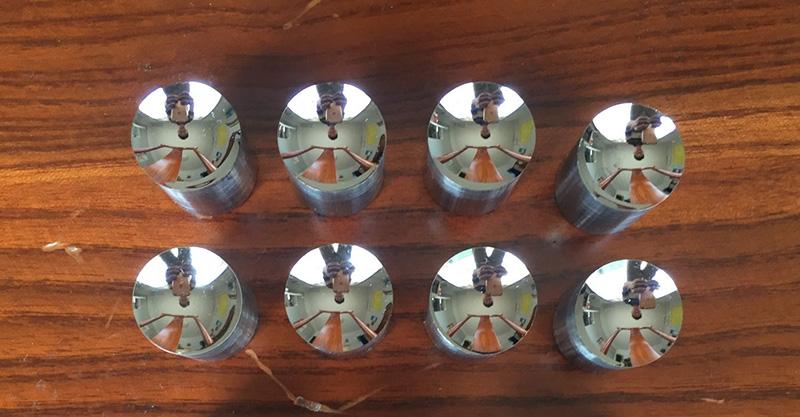Electrolytic polishing uses the workpiece to be polished as the anode, insoluble metal as the cathode, and both poles are immersed into the electrolytic cell at the same time. Through DC ionization reaction, selective anode dissolution is generated, so as to remove fine burrs on the workpiece surface and increase the brightness.
Today, we will share with you questions and answers about the basic knowledge of electrolytic polishing in the daily processing and production of electroplating, hoping to help those in need.
1. Why are there grey and black patches on the polished surface?
Cause analysis: the oxide skin may not be completely removed. Oxide scale still exists locally.
Solution: strengthen the removal of oxide scale
2. What is the cause of the excessive corrosion at the corners and tips of the workpiece after polishing?
Cause analysis: excessive dissolution is caused by excessive current at edges, corners and tips, or excessive electrolyte temperature and polishing time.
Solution: adjust the current density or solution temperature, or shorten the time. Check the electrode position, and set shielding at the edges and corners.
3. Why is the workpiece not bright and grey and dark after polishing?
Analysis reason: it is possible that the electrochemical polishing solution has no effect or the effect is not obvious.
Solution: check whether the electrolytic polishing solution has been used for too long, the quality has decreased, or the proportion of solution components is out of proportion.
4. What is the white stripe on the polished surface of the workpiece?
Cause analysis: the relative density of the solution is too large and the liquid is too thick. The relative density is greater than 1.82.
Solution: increase the stirring degree of the solution. If the relative density of the solution is too large, dilute it to 1.72 with water. And heated at 90 ~ 100 ℃ for one hour.

5. Why are there Yin and Yang surfaces on the polished surface, and some parts are dull?
Cause analysis: the position of the workpiece is not aligned with the cathode, or the workpiece is shielded from each other.
Solution: properly adjust the workpiece to make the position between the workpiece and the cathode appropriate and make the power distribution reasonable.
6. After polishing, the surface of the workpiece is flat and smooth, but some points or blocks are not bright enough, or vertical non bright stripes appear. What is the general reason?
Cause analysis: it may be that the bubbles generated on the surface of the workpiece in the late polishing period fail to detach and attach to the surface in time or there is an air flow line on the surface.
Solution: increase the current density, increase the gas evolution amount so that bubbles can desorb, or increase the stirring speed of the solution to increase the flow of the solution.
7. The contact point between the parts and the hanger is dull and has brown spots. What is the reason why the rest of the surface is bright?
Cause analysis: the poor contact between the parts and the hanger may cause uneven current distribution, or the parts and the hanger have few contact points.
Solution: polish the contact point of the hanger to make it conductive, or increase the area of the contact point between the part and the hanger.
9. Some parts polished in the same groove are bright, some are not bright, or some parts are not bright.
Cause analysis: there are too many workpieces polished in the same groove, resulting in uneven current distribution, or overlapping and shielding between workpieces.
Solution: reduce the number of polished workpieces in the same groove, or pay attention to the placement of workpieces.
10. Why are there silver white spots near the concave part of the polished part and the contact point between the part and the hanger?
Cause analysis: the concave part of the part may be shielded by the part itself or the hanger.
Solution: properly change the position of the parts so that the power lines can be obtained at the concave parts, or reduce the distance between the electrodes or increase the current density.
11. What is the reason why there is no light and yellow spots after polishing?
Cause analysis: the relative density of the electrochemical solution may be too small, which is less than 1.70.
Solution: adjust the relative density of electropolishing or heat and concentrate at 80-100 ℃ to increase the relative density. Or replace with a new fluid.
12. Why do brown spots appear when the workpiece is taken out of the groove after polishing?
Cause analysis: it may be that electropolishing is not enough or the time is short.
Solution: first of all, properly extend the polishing time. If it does not work, it may be the problem of insufficient temperature or current density.
13. Why is it easy to ignite during electrolysis?
Cause analysis: there are three factors leading to this phenomenon: first, the contact point between the hanger and the workpiece is not firm, second, the density of electrolyte is too low, and third, the current density is too high.
Solution: change several connection methods between the hanger and the workpiece, and increase the contact points between the hanger and the workpiece as much as possible. If the electrolyte density is too low, replace the electrolyte.



nice informations، good to share experience۔